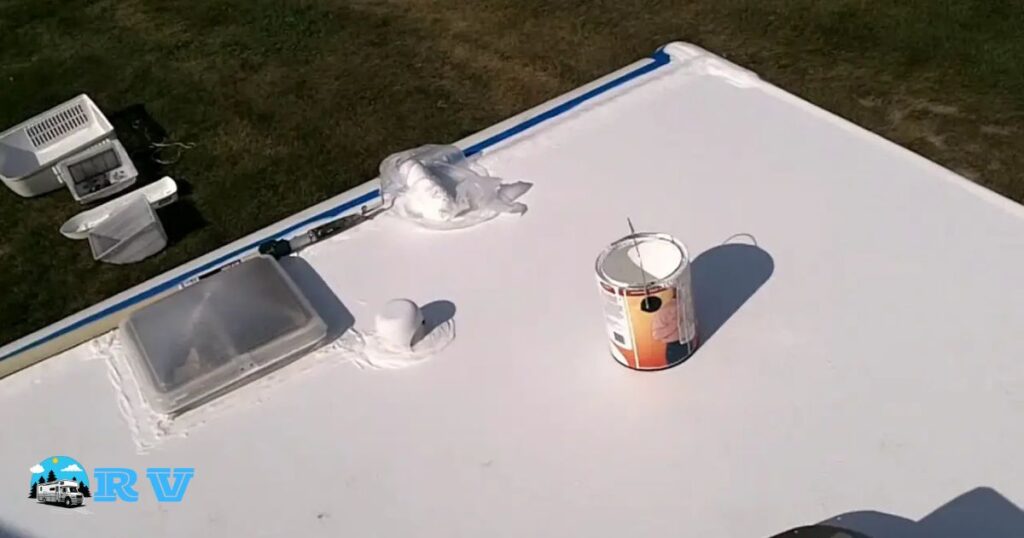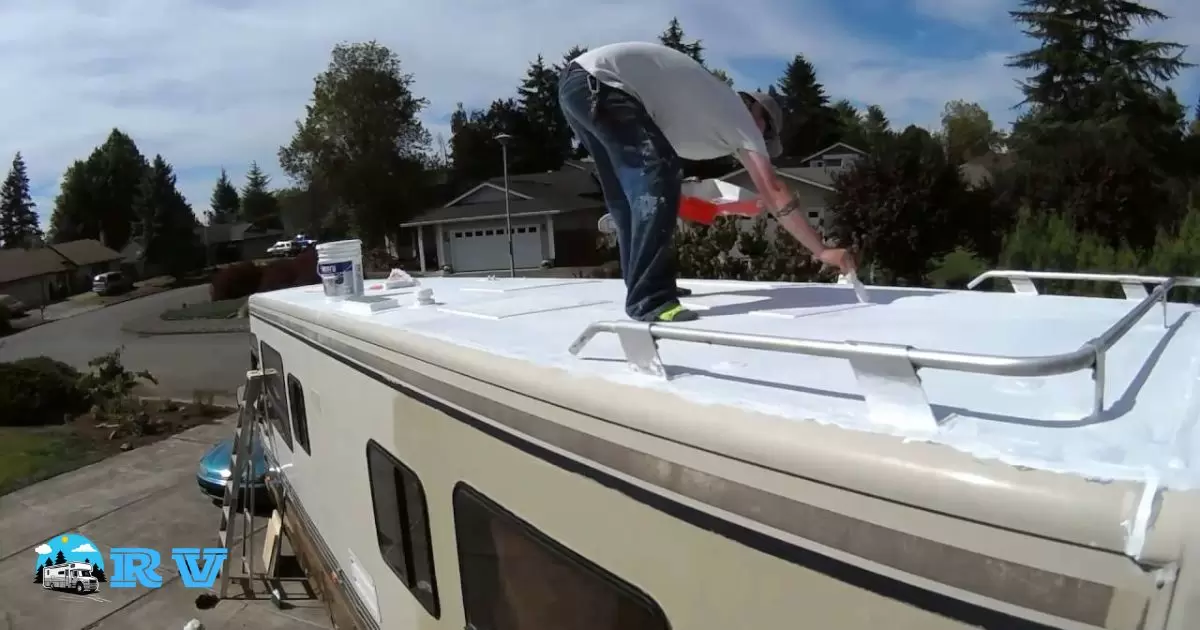Sealing your RV roof involves applying a protective coating or sealant to prevent leaks, water damage, and UV degradation. This maintenance task helps extend your RV’s lifespan and ensures a watertight seal on the roof, preserving the interior and preventing costly repairs. Regular roof sealing is essential for maintaining the structural integrity of your recreational vehicle.
Ever wondered, How often should you seal your RV roof for ultimate protection? Discover the key to safeguarding your precious investment. Don’t wait for leaks. Click here to learn the crucial timeline for roof sealing and ensure your RV journeys stay worry free.
To keep your RV in top shape, it’s important to know how often you should seal the roof. Typically, experts recommend resealing every one to three years, depending on factors like climate and usage. Regular maintenance ensures a leak-free and long-lasting adventure on the road.
Sealing Your RV Roof How Often Is It Necessary
Sealing your RV roof is essential to protect your investment and keep your home on wheels in top condition. But, how often should you do it? Typically, experts advise resealing your RV roof every one to three years.
Regular maintenance and inspections are key to preventing leaks and ensuring your RV stays comfortable and dry throughout your travels. So, stay vigilant and follow a routine maintenance schedule to extend the life of your RV and enjoy peace of mind on your adventures.
| Topic | Key Information |
| Sealing Frequency | Every 1 to 3 years, depending on factors like climate and usage. |
| How to Seal Your RV Roof | Clean the surface, apply a quality RV roof sealant, and follow manufacturer’s instructions. |
| Why Reseal Your RV Roof | To protect against elements, prevent leaks, and maintain structural integrity. |
| When to Check for Cracks in Seals | At least twice a year (spring and fall) and before long trips to avoid unexpected leaks. |
| Preventing RV Roof Damage | Regular cleaning, using a protective cover, and UV-resistant coatings and sealants. |
| Determining When to Reseal | Inspect for visible cracks, peeling, and wear on the sealant, frequency varies with usage. |
| Cost of Resealing an RV Roof | Ranges from $300 to $600, depending on factors like roof type, RV size, and DIY vs. professional. |
How To Seal Your RV Roof?
Sealing your RV roof is a straightforward process that begins with cleaning the surface to remove dirt and debris. Once it’s clean, apply a quality RV roof sealant, starting from the front and working your way to the back. Make sure to follow the manufacturer’s instructions for the specific product you choose.
It’s a good practice to inspect your RV roof regularly for any signs of wear or damage, and reseal as needed to maintain the integrity of your vehicle’s roof and avoid costly repairs down the road. Regular roof sealing will keep your RV in excellent condition and ready for your next adventure.
Why You Need To Reseal Your RV Roof

Your RV’s roof is its first line of defence against the elements. Over time, exposure to harsh sun, rain, and temperature fluctuations can cause the sealant to deteriorate. Leading to potential leaks and costly damage. Regularly resealing your RV roof is crucial to maintain its structural integrity and protect your investment, ensuring worry-free travels and preserving your home on wheels.
Neglecting roof maintenance can result in water seepage, compromising the interior, and causing structural issues. By proactively resealing your RV roof, you prevent these problems, saving you from expensive repairs and the inconvenience of unexpected leaks during your adventures.
Roof Damage
Roof damage can lead to costly repairs and water leaks inside your RV. That’s why resealing your RV roof is essential to prevent such issues and maintain your vehicle’s integrity. Protect your investment with regular roof maintenance.
Aging
Ageing is a natural process, and so is the wear and tear on your RV roof. Resealing is vital to combat the effects of time, safeguarding your RV from leaks and costly repairs. Keep your home on wheels protected and your adventures worry-free with proper roof maintenance.
Loosened Screws
Loosened screws on your RV roof can lead to water leaks and damage. Resealing your roof prevents this issue, securing your RV for worry-free travels. Don’t overlook the importance of tight, waterproof seals to keep your adventures dry and stress free.
When Should You Check for Cracks in the Seals?
Checking for cracks in the seals of your RV is a crucial part of routine maintenance. Ideally, you should inspect the seals at least twice a year, typically in the spring and fall, when temperatures and weather conditions change.
It’s a good practice to examine them before any long trip to avoid unexpected leaks and potential damage. Regular inspections help you catch and repair cracks early, ensuring your RV remains water-tight and ready for your next adventure.
How Often Should You Seal/Reseal Your RV Roof?
Maintaining a healthy RV roof is key to a trouble free journey. So, how often should you seal or reseal it? Generally, experts suggest performing this task every one to three years. This proactive approach keeps your RV protected from potential leaks and extends its lifespan, ensuring your adventures remain smooth and worry free.
Remember, prevention is the best cure when it comes to RV maintenance. Regularly inspecting your roof and staying on top of sealing can save you from costly repairs down the road. By following a consistent sealing schedule, you’ll enjoy a durable and reliable roof that stands up to the rigors of the open road.
How to Prevent RV Roof Damage
Preventing RV roof damage is essential for a stress-free and enjoyable journey. Start by routinely inspecting your roof for cracks, tears, or signs of wear. Ensure that tree branches and debris are cleared from your RV’s path, and avoid parking under low hanging trees.
Investing in proper maintenance and occasional resealing of your RV roof can significantly extend its lifespan. When travelling, be mindful of height restrictions to prevent accidental collisions with bridges or overhangs. Lastly, store your RV under a protective cover or in a garage during long periods of inactivity to shield it from the elements.
Regular Cleaning
Regular cleaning is a vital step in preventing RV roof damage. Removing dirt, debris, and tree sap helps maintain the roof’s integrity and extends its lifespan. Make it a habit to clean your RV roof to ensure it stays in great condition.
Use A Protective Cover
Protect your RV roof by using a protective cover when it’s not in use. This simple step shields your vehicle from the elements, preventing damage and extending its lifespan. Invest in a cover to keep your RV in top condition.
Use Other Protectants
Preventing RV roof damage can be as simple as using other protectants like UV-resistant coatings and sealants. These products act as a shield against the sun’s harmful rays and weathering, extending your roof’s lifespan.
How To Determine If You Need To Reseal Your Roof
Determining if it’s time to reseal your roof is crucial for preventing potential damage. Start by inspecting the roof for any visible cracks, peeling, or wear on the existing sealant. If you notice these signs, it’s a clear indicator that resealing is needed to maintain your RV’s protection. Regular inspections can help you catch issues early and avoid costly repairs.
Keep in mind that the climate and your RV’s usage can affect the resealing frequency. If you frequently expose your RV to harsh weather or use it frequently, you may need to reseal more often, typically every one to three years. Taking proactive steps to determine when resealing is necessary ensures your RV roof remains durable and leak free.
How Much Does It Cost To Reseal An RV Roof?
Resealing an RV roof can be a cost-effective maintenance task. On average, the cost ranges from $300 to $600 for the materials and labor, but it can vary based on factors like the type of roof, size of the RV, and whether you choose to DIY or hire a professional.
If you decide to reseal your RV roof yourself, the expenses will mainly cover the cost of sealant and any necessary tools. On the other hand, hiring a professional service may cost more, but it often comes with a warranty and the assurance of a job well done, providing peace of mind for your future travels. When it comes to DIY resealing, one important factor to consider is the quantity of gallons of RV antifreeze you’ll need, ensuring you have all the essentials for a successful job.
FAQ’s
How much roof sealant do I need for RV?
The amount of roof sealant needed for an RV depends on its size and the type of sealant, but typically, a 5-gallon container is sufficient for most RVs.
What maintenance does a RV roof need?
An RV roof requires regular cleaning to remove debris and a periodic application of sealant to prevent leaks and protect against UV damage.
How long does RV roof sealant last?
RV roof sealant typically lasts for about 1 to 3 years, but its longevity can vary depending on factors like climate, usage, and the quality of the product used.
Conclusion
The frequency with which you should seal your RV roof is a crucial aspect of maintenance to ensure the longevity and protection of your investment. While a general guideline recommends resealing every one to three years, it’s essential to take into account various factors, including the climate in which you use your RV, the quality of sealant, and the level of wear and tear your roof endures.
Regular inspection is equally important; be vigilant for any signs of damage or wear in seams and edges, as addressing these issues promptly can prevent more extensive problems.
By adhering to a routine sealing schedule and staying proactive in maintenance, you’ll keep your RV in tip-top condition, ready for countless safe and enjoyable adventures on the road. So, remember, maintaining your RV’s roof is not just a task, it’s a safeguard for the comfort and security of your travels.











